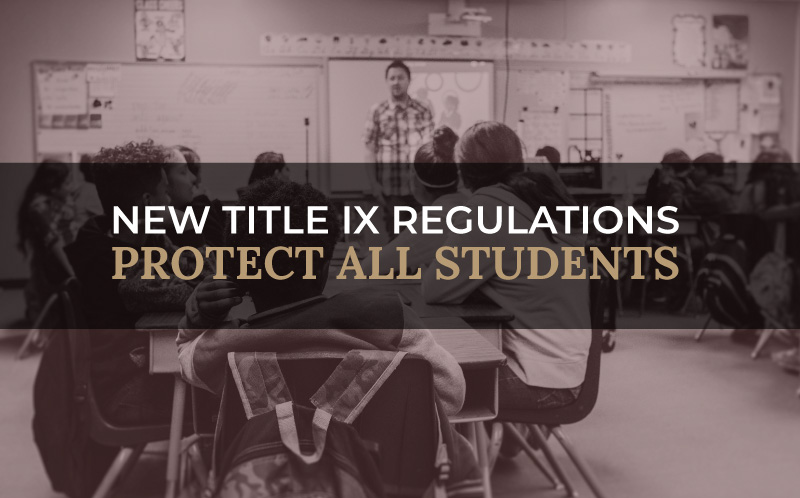New Title IX Regulations Strengthen Protections for All Students

In May 2020, the U.S. Department of Education announced new Title IX regulations, taking full effect in August 2020. One of our Michigan sexual assault attorneys – Stephen Sinas – appeared recently on WLAJ “In the Name of the Law” to discuss the process of sexual assault civil lawsuits and the various changes to the federal Title IX regulations.
Understanding Sexual Assault Civil Lawsuits
Civil lawsuits regarding instances of sexual assault have their own unique set of standards. Perpetrators of sexual assault can be held financially liable for their actions. However, oftentimes when that person does not have considerable assets or wealth, financial recovery for victims directly from the perpetrator proves difficult. Additionally, it’s important to understand that most insurances issued to an individual do not cover instances of sexual assault. Because most insurances view sexual assault as intentional or criminal acts, most policies do not cover these situations or provide any redress for victims.
Can you sue a person or entity for a sexual assault committed by someone else altogether?
However, in some instances of sexual assault, other individuals or entities – such as employers of the perpetrator or owners of the property where the assault took place – can also be held liable for the sexual assault. In these cases, assault survivors may be able to argue that these other individuals or entities failed to make reasonable efforts to prevent the assault from occurring or failed to take appropriate corrective action once notified of the improper actions. The standard in these types of claims is essentially the same as a general negligence standard.
It’s important to note here that, that if the “other person or entity” is a government employee or governmental entity, such as a school system, an even higher standard applies. Under government immunity principles, those injured as a result of the actions of a governmental entity or employee must prove gross negligence in failing to prevent the sexual assault.
When assaults occur in the school setting, the federal Title IX law applies. In August of 2020, the Department of Education amended this federal law to strengthen protections for students. We have discussed the intricacies of Title IX before and instances of campus sexual assault, and below we explore the changes to these regulations.
What are the New Title IX Regulations?
Congress passed the federal civil rights law known as Title IX as part of the Education Amendments Act of 1972. The law prohibits discrimination of any kind in schools that receive federal funding assistance. The courts have held that sex discrimination includes such acts as sexual assault or sexual harassment. Therefore, schools can be held liable for instances of sexual assault that occur within the school environment.
The Department of Education published the new Title IX rule in May of 2020 and became effective on August 14, 2020. The new Title IX law essentially supersedes the existing regulations and the letters of guidance that were issued by the Office of Civil Rights regarding Title IX over the past 25 years. Additionally, it provides a framework for the grievance process in the school in addition to private causes of action. This new law is consistent with case law and decisions issued by the United States Supreme Court that have dealt with Title IX. There are striking similarities between the former Title IX law and the new Title IX law, but also many differences. Below is a list of key provisions of the new Title IX regulations:
- Defines sexual harassment to include: sexual assault, dating violence, domestic violence, and stalking, as unlawful discrimination based on sex
- Provides a consistent, legal sound framework on which survivors, the accused, and schools can rely
- Requires to schools to disclose clear, accessible options for reporting sexual harassment
- Empowers survivors to make decisions about how a school responds to incidents of sexual harassment
- Requires schools to provide supportive measures, such as class or dorm reassignments or no contact orders
- Protects K-12 students by requiring elementary and secondary schools to respond promptly when any school employee has notice of sexual harassment
- Holds colleges responsible for off-campus sexual harassment at houses owned or under the control of school-sanctioned fraternities and sororities
- Restores fairness on college and university campuses by upholding all students’ right to written notice of allegations, the right to an advisor, and the right to submit, cross-examine, and challenge evidence at a live hearing
- Shields survivors from having to come face-to-face with the accused during a hearing and from answering questions posed personally by the accused
- Requires schools to select one or two standards of evidence – the (1) preponderance of the evidence standard or the (2) clear and convincing evidence standard – and to apply the selected standard evenly to proceedings for all students and employees, including faculty
- Provides “rape shield” protections and ensures survivors are not required to divulge any medical, psychological, or similar privileged records
- Requires the school to offer an equal right of appeal for both parties to a Title IX proceeding
- Gives schools flexibility to use technology to conduct Title IX investigations and hearings remotely
- Protects students and faculty by prohibiting schools from using Title IX in a manner that deprives students and faculty or rights guaranteed by the First Amendment
Read more about the new Title IX regulations here on the U.S. Department of Education’s website.
Can I Sue a School for Sexual Assault?
Schools can be held liable for instances of sexual assault if an appropriate person within the school organization was properly notified of inappropriate sexual assault or behavior was occurring and they failed to act on that notice. The new Title IX regulations applicable to elementary and secondary schools deem any employee within the organization as an appropriate person to receive notice. Therefore, any school employee receiving such notification must report it.
That is not the same for colleges, universities, and post-secondary education institutions. In these types of settings, the school board, Title IX coordinator, or another person responsible for taking corrective action must receive the notification. Therefore, in instances of sexual assault in which the school received notification of the circumstance yet failed to respond with corrective action, the survivor of the assault will likely have a cause of action to file suit against the school for damages. Title IX is a very important law for survivors and provides a path for seeking redress for injuries against institutions that failed to protect them. You can read more about the importance of holding schools accountable for instances of sexual assault here.
However, schools are not the only organization or institution that can be held liable for sexual assaults. This page discusses institutional sexual assault more in-depth, such as assaults that occur in medical settings, assisted living facilities, and religious institutions.
Does the perpetrator have to be a school employee?
Title IX provides two main avenues for bringing a claim – one area focuses on teacher-on-students type of assault while the second avenue involving student-on-student situations requires a slightly different analysis. This second instance of assault, student-on-student, might occur anywhere on school property, at a school function or extra-curricular activities, within dorms or school-sponsored housing, within the classroom, etc.
Are sexual assault cases difficult to prove?
The elements to meet and how you present these types of claims differ. One type of claim is not necessarily more difficult to bring than the other in these instances. Every case is unique and individual, requiring thoughtful evaluation by a legal team experienced handling complex instances of sexual assault.
Ultimately, the Plaintiff is responsible for providing proof of not only the assault but the proper notification of the assault and deliberate indifference to that notice by the school. Witness testimony is very strong in proving these types of cases. Our attorneys who regularly represent survivors of sexual assault routinely receive inquiries regarding whether or not a person has a case. At the end of the day, the reality is, in cases when it’s a direct instance of sexual assault not involving an organization or institution, the unfortunate reality is there oftentimes is no course of action for pursuing damages directly from the perpetrator. However, in instances of campus sexual assault, the new Title IX regulations provide all students with increased protections making schools safer.

